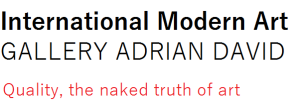Robert DANDAROV
Robert Dandarov, oil on canvas, 2011 Macedonian American artist Robert Dandarov’s work takes a journey through fact and fantasy. He analyses his modern era and emphasizes the obsession with violence and illusion. His narrative talent displays a visual language based on mythology, history, religion, science and literature. From this unlimited universe, he explores a possible […]
Gio POMODORO
Gio Pomodoro, bronze, 1971 The Italian artist Gio Pomodoro is known for his often large sculptures and jewellery designs. He took the static out of sculptures by incorporating supple forms that insinuate movement. He created a play of light and shadow that stand out due to their three-dimensional nature. His monumental sculptures have an important […]
Johan TAHON
Johan Tahon, polyester, 2003 The sculptures by the Belgian sculptor Johan Tahon are like an expression of an all-embracing silence. A constant search within himself leaves visible traces and makes his work very personal. The charge of his expressions, full of emotion and thought, crosses the boundaries of the unknown. Tahon’s work represents mankind as […]
Jörg PLICKAT
Jörg Plickat, Corten Steel, 2017 The German sculptor Jörg Plickat creates a formal language in stainless steel and Corten steel. His forms are abstract and geometric, they seek a balance between monumentalism and fragility. The artist investigates the relationship between volume and material. His powerful shapes can be found worldwide in museum parks and spacious […]
LUO BROTHERS
The Luo Brothers, lacquer on wood, 2006 The three Chinese brothers who make up the artist trio The Luo Brothers grew up during the Cultural Revolution. It was a time when China was rapidly changing politically and culturally. In the mid-1990s, their work is typified by the combination of traditional references and Western consumerism. The […]
Zhengjie FENG
Feng Zhengjie, oil on canvas, 2001 The work of the Chinese artist Feng Zhengjie is characterized by the bright use of colour. He found his inspiration in traditional colourful drawings that gained popularity throughout the imperial dynasties. His mostly female models are borrowed from the advertising world with eccentric features such as a lush head […]
Jim DINE
Jim Dine, pencil on paper, 1962 The American Jim Dine is a key figure of the early Happenings. This artist is considered to be pop art, but was more closely associated with neo-dada and neo-expressionism. The technical variety within his own style makes it difficult to categorize him. Every object he used had a deep […]
Wenda GU
Gu Wenda, Chinese ink, 1985 A common thread running through Gu Wenda’s oeuvre is the disruption of inequality. His self-created pseudo-language includes illegible so-called Chinese characters, with which the artist points out the limits of communication and manipulation of language. The Chinese authority, not susceptible to imaginary ideograms, forbade him in 1986 to open his […]
Makoto NAKAMURA & Shigeo FUKUDA
Makoto Nakamura & Shigeo Fukuda, collage, 1971 The Japanese artists Makoto Nakamura and Shigeo Fukuda developed a ‘Games of visual art’ from the advertising world. They led a visual language of contradictions where objects and images engage in an optical battle. In the margins of art they manipulate the grid of photography and their work […]
George SEGAL
George Segal, plaster, 1982 The American artist George Segal became famous in the 1960s with pure white plaster sculptures. He wrapped living models in plaster bandages and created his hardened casts directly into art. He placed his figures in a realistic environment, combined with everyday objects. This method of presentation showed a close connection with […]
